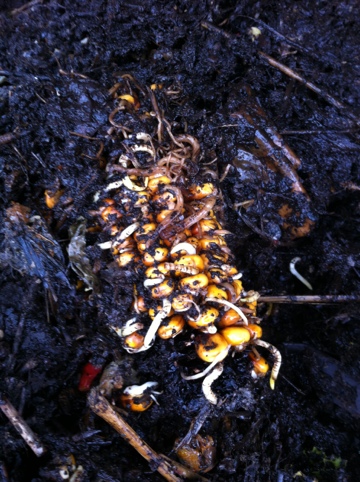For the past three years I have composted our household plant waste. Coffee grounds, tea bags, kitchen scraps, forgotten vegetables gone bad. Our pet rabbit’s nitrogen-filled litter. We keep 3 gallons a week out of the waste stream, I have given no leaves for autumn collection since I started. Living lighter on the city land.
It has taken three years to fill, since in the compost the plants’ carbon shells dehydrate. All life is dust without water.
The compost is a green ventilated plastic cylinder 3 feet tall and wide. It has no smell when closed. Most people ignore it. Inside is a dense heavy loam, rich with concentrated organic matter. It has a thriving colony of earthworms and in warm weather is active with insects. Molds blow across like storms.
For the autumn Jackie hung dried corn cobs on our door. When the corn gave way to a wreath I broke the cobs and added them to the compost. The cobs were dry, the kernels stiff as cardboard. They had been washed in purple dye. I worried about chemicals but we had bought them at an orchard.
For a long time they didn’t decompose. Were they plastic? Just tenacious. One is now sprouting, nourished in total darkness by our rotting discards. It is a heady thing to see such life, too much for our scaly urban exteriors, when tickle becomes squirm. Perhaps this is the true collective fear that we stroke with zombie stories — the potential in our waste.
Rick Santorum has it wrong to say we should not serve the earth. It is a creation larger than we are and it houses us. It will be here long after we are gone and our kids will need it too. It is more deserving of love.
Tag: Compost
-
Zombie corn
